In Fashion: Joni Mitchell Always Ran Ahead of the Pack, in Song and in Style

“The last time I photographed Joni, as she was leaving the studio, she turned around and looked me in the eye and said, ‘So Norman, what have you learned after all these years of working on yourself?’ I laughed it off and didn’t answer at the time. In my most recent book, published in 2018, the storyline commentary describes my experience working with great artists that I call ‘boundary dweller creators,’ willing to jump into the unknown and go beyond boundaries that most people don’t cross. It took a couple decades, but that was my answer to her question. This image is a direct lift from the contact sheet (opposite) that I had marked with a grease pencil to provide selects for printing.” Photo: Norman Seef
As Joni Mitchell turns 80 on Nov. 7, revisit portraits and reminiscences by photographer Norman Seeff about his 1972-1985 photo sessions with the music legend from our Aug./Sept. 2023 issue.
There is a video of Joni Mitchell singing her song Coyote that encapsulates everything I love about her style. She throws a pair of skates into a red sports car, then turns to offer her hand to a coyote hanging out nearby. The real-life coyote was faithless American playwright Sam Shepard, and the 1976 song includes one of history’s most devastating character sketches of a lover with insatiable appetites: “He’s picking up my scent on his fingers/While he’s watching the waitress’s legs.”
How could anyone ever have left Joni? She was, to use another canid metaphor, a stone fox. In the clip, her lips are richly painted, and her blond hair is barely contained by her beret. There’s a bit of Joan Collins about her, in the majestic shoulder pads of her black jacket and her high-heeled black boots. It’s as if she’s saying — not just to Shepard, but to every lanky Beverly Hills cowboy and bell-bottomed troubadour struck dumb by her brilliance and beauty — “You see what you’re missing, boys?”
In reality, though, Joni was always leaving them. Freedom, not the Northern Star, is the great constant in her songs. She was always chasing Amelia Earhart across the desert or taking a misbegotten flight away from her lover. She once dumped a boyfriend, singer-songwriter Graham Nash, by sending him a telegram that said, “If you hold sand too tightly in your hand, it will run through your fingers.’’ Only someone who understood this compulsion could sing, “We love our loving, but not like we love our freedom.” Has any artist ever made running away sexier?

In her style, too, she was always on the run, at the head of the pack. In the mid-’60s, she was a groovy Yorkville hippie chick in miniskirt and Mary Janes, hiding behind a curtain of blond hair; a beacon in a marigold-yellow maxi dress at the Isle of Wight Festival; a lady of the canyon working the 1970s California vibe in kaftan and beads. But then her music changes, and so does her style: In the 1980s and ’90s, she was a throaty-voiced jazz singer in beret and bare arms, a cool cat. Finally, we have today’s maximalist Mitchell, a survivor who embraces colour and pattern and excess, her lips a brilliant red as she blows kisses to the devoted who gather to hear her ageless songs. Last summer, when she made her first public concert appearance in 20 years at the Newport Folk Festival — where she mesmerized the audience in 1967 — she was seated on a throne-like armchair, majestic in sunglasses and ropes of beads, her silky top printed with soaring white cranes. A live album of that performance, At Newport, came out July 28.
Can you sing about the pain of absence while still surrounded by luxurious things? Mitchell understands these tensions better than anyone. She likes beautiful clothes, and handsome men, as well as her liberty. Material things are not a prison, as her hippie peers might have argued. They’re the way we build a home for ourselves, no matter where we are. “I miss my clean white linen and my fancy French cologne,” she sings in Carey, from her 1971 masterpiece Blue. She has beach tar on her feet, and a hot man waiting for her in a Greek cave, but she’s being pulled apart. Before she splits, she’ll put on her silver and dance with him under a Matala moon.

“I’ve always been interested in glamour,” she said in the 2003 documentary Joni Mitchell: Woman of Heart and Mind. A painter from an early age, she was her own canvas all along. In high school in Saskatoon, Sask., she wrote a column called Fads and Fashion, and later entered a beauty contest with her hair in a prim bouffant. She made her own clothes and worked part-time as a model at a nearby department store. As a girl, she dreamt of being a fashion designer, her biographer David Yaffe reveals in his book Reckless Daughter.
Maybe that’s why her songs are so full of colour and texture, clothing and fabric, from the crimson crystal beads of Chelsea Morning to Trina sewing lace on widows’ weeds in Ladies of the Canyon. Mitchell understood fashion and its symbolism from within: Her tools were a guitar and piano, but a needle and thread as well. When she married American singer Chuck Mitchell in 1965, she made her own wedding dress, after all — an accomplishment she shared with that other wild-spirited Canadian sprite, Margaret Trudeau.
What a sense of freedom there must have been, slipping into the fringes and shawls of a bohemian goddess after all those years in frigid and (literally) buttoned-up Saskatoon. The freedom to float in a black bikini in her lush blue swimming pool, in a famous Norman Seeff photograph that would have countless girls dreaming of ditching their textbooks to hitchhike westward to Hollywood instead. The freedom from girdles and hairspray; the freedom from having to be a good girl. Mitchell invited her parents to her first Carnegie Hall gig in 1969, and just before she went on stage, her very proper mother said: “Oh Joan, you’re not going on in those rags!”

Even Mitchell grew tired of the gauzy fairy tale aura. “I shouldn’t be stereotyped as a magic princess, like I got earlier in my career. The twinkle twinkle little star kind of attitude,” she told an interviewer in 1973. “I didn’t like that feeling.’’ She was steel inside — you’d have to be to take on the music industry ogres — and before too long her outside began to reflect that, too. In the ’80s, her princess’s hair was permed, and she started to wear trousers or culottes on stage. She chose the sharp-shouldered jackets of a mob boss, and the oversized sunglasses too. Her beret became her signature, but not only, headwear.
That beret is a mainstay in Mitchell’s latest style incarnation, which might just be my favourite. In 2015, she suffered a debilitating brain aneurysm. “It took away my speech and my ability to walk,” she said in 2020. Part of the recovery process involved holding Joni Jams in her Los Angeles living room, with performers ranging from Dolly Parton to Chaka Khan. That living room is so lovingly curated that Elton John called it “one of the most special rooms I’ve been to in my whole life,” in a 2022 conversation at Mitchell’s home for his Apple Music show, Rocket Hour with Elton John. And if Elton loves your decorating, you know you’ve got a gift for style.
Mitchell wore a red beret in that interview with John, a beautiful floral robe, crimson fingernails. Two long blond braids, girlish and defiant. Everything about her look is defiant: It’s as if she’s giving the finger to illness, and to a world that wants to shrink older women and make them dim and obedient.
At the Gorge Amphitheatre in Washington State this past June — alongside a stellar lineup of singers, including Joni Jam catalyst Brandi Carlile — the beret was back. It was black this time, but the rest of her was a riot of colour, her lips and nails and another bright flowered kimono. Her hand rested on a cane topped with a silver bear’s head. She is boundless, like the rivers and skies she writes about. She is her own woman, and free.
A version this article appeared in the Aug/Sept 2023 issue with the headline ‘In Fashion’, p. 42.
RELATED:
Joni Mitchell Joins Brandi Carlile for a Surprise “Joni Jam” at Hollywood Bowl
Song for Joni: Tracing a Life Inspired by the Music of Joni Mitchell